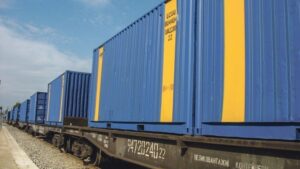
In January-May 2024, Ukrzaliznytsia (UZ) increased the volume of cargo transportation by 29.9% to 75.43 million tons compared to the same period in 2023.
At the same time, according to an analytical note prepared for a meeting of the Exporters’ Office on Friday, in May, the volume of grain cargo transportation to ports for the first time reached the level that preceded the full-scale invasion. Exports of ore, building materials and cement also increased significantly.
“The increase in transportation volumes is due to the activity of cargo exports, largely due to the opening of sea routes. At the same time, massive rocket attacks have significantly affected the state of the energy sector, certain industries, and transport infrastructure, which affects the dynamics of cargo transportation,” the note says.
The volume of cargo transportation by Ukrzaliznytsia in export traffic in January-May increased by 56.7% to 37.97 million tons. Over the five months, the share of rail freight exports increased by almost 9 percentage points to 50.4% of the volumes transported by various modes of transport. In the first five months of 2023, it was 41.7%.
In May, the volume of cargo transportation for export increased by 7.4% compared to April to 7.55 million tons. In May 2023, this figure doubled (+3.76 million tons).
According to the main nomenclature of export transportation in May, grain cargo took the first place – 3.28 million tons (43.4% of the total volume of cargo transported by rail for export in May), iron and manganese ore took the second place – 2.7 million tons (35.8%), and ferrous metals took the third place – 410 thousand tons (5.5%).
Thanks to the work of the Ukrainian Sea Corridor and the gradual resumption of production at the mining and metallurgical enterprises, the export of iron and manganese ore has increased significantly, UZ noted.
In addition, it is reported that the volume of grain cargo transportation towards ports in May for the first time reached the level that preceded the full-scale invasion. The company transported 2.91 mln tons, which is 0.6% more than in February 2022. In the direction of the land crossings, 361.7 thousand tons were transported, which is 5.6 times more than in February 2022.
The volume of grain cargo transportation for this period in 2024 increased by 38.9% compared to the same period last year – up to 16.17 mln tons. In May, the volume of grain exports amounted to 3.28 million tons, up 10.1% compared to April.
The volume of iron and manganese ore exported in the first five months of 2024 increased 2.1 times compared to the same period in 2023, to 15.2 million tons. In May, the volume of ore exports increased slightly compared to April, by 2.8% to 2.7 million tons. The company transported 1.39 million tons (51.6% of exports) to seaports and 1.3 million tons via land crossings.
Exports of ferrous metals increased by 4% to 2.02 million tons over the reporting period. In May, 414.6 thousand tons of ferrous metals were transported in export traffic, up 1% compared to April.
The volume of exports of ferrous metals in the direction of seaports amounted to 305.6 thousand tons (73.7%), and 109 thousand tons through land crossings. It is noted that in May-2024 compared to May-2023, the volume of exports of ferrous metals fell by 12.2% (57.6 thousand tons).
The volume of vegetable oil exports for 5 months increased by 20.3% compared to the same period last year – up to 770.9 thousand tons. In May, it amounted to 195.1 thsd tonnes, up 28.7% compared to April.
As noted, the oil is exported mainly through land crossings, through which 140.4 thsd tonnes (72% of the total) were exported in May, and 54.7 thsd tonnes through seaports. Compared to May-2023, in May-2024, the volume of vegetable oil exports increased by 68.6% (+79.4 thsd tonnes).
Exports of building materials increased to 1.22 million tons. In May, the highest export volume of construction materials was recorded – 358.4 thousand tons, which is 11% more than in April.
Cement exports increased by 40.6% to 566.5 thousand tons over 5 months. In May, the highest volume of cement exports over the past five years was recorded – 151.4 thousand tons, which is 10.2% more than in April 2014.
“For several years in a row, there has been a trend of gradual growth in cement exports by rail. In the direction of the EU, cement is exported through land border crossings,” UZ noted.
In general, exports through land border crossings decreased by 8.9% over five months compared to the same period last year to 13.33 million tons. In May, it amounted to 2.69 million tons (35.6% of total exports), which is 3.6% less than in April.
At the same time, exports through seaports increased 2.6 times to 24.61 million tons. In May, it amounted to 4.86 million tons (64.4% of total exports), up 9.7% compared to April. The bulk of cargo went to the ports of Greater Odesa (92%) and only 8% to the Danube ports.
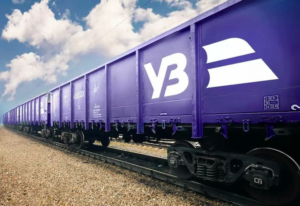
In January-May 2024, Ukrzaliznytsia (UZ) transported 75.4 million tons of cargo, up 30% from the same period in 2023, the UZ press service said on Monday.
About half of all cargo (38 million tons) was transported for export, which is 57% more than in January-May 2023, the report said.
“We ensure stable operation and transport commercial cargo in full. According to the results of five months, we have quite significant indicators both in total transportation volumes and in the strategic export traffic for the country. In particular, we increased grain exports by 39% compared to last year. We are ready to continue to fully meet the country’s economy and business transportation needs,” the statement quotes Yevhen Liashchenko, Chairman of the Board of UZ, as saying.
In January-May 2024, the volume of transportation in domestic traffic increased by 6.7% compared to January-May 2023 to 32.9 million tons. Cargo imports increased by 68.5% to 4.3 million tons, while exports increased by 57% to 38 million tons.
As noted, iron and manganese ore led the way in the transportation volumes for the period under review – 19.3 million tons; grain cargo – 18.8 million tons; coal – 11.5 million tons; and building materials – 10.8 million tons.
Earlier it was reported that in January-April 2024, UZ increased the volume of cargo transportation by 28.7% compared to the same period in 2023 to 59.9 million tons, while in the export direction this figure increased by 48.8% to 30.4 million tons.

In January-March 2024, Ukrzaliznytsia JSC (UZ) increased export transportation to ports by 2.4 times compared to the same period in 2023 – up to 15.347 million tons, while reducing the volume of transportation through land crossings in export traffic by 11.9% to 8.041 million tons, according to an analytical note of the company following the meeting of the Exporters’ Office.
In total, Ukrzaliznytsia transported 44.69 million tons of cargo in the first quarter of this year, which is 28.7% more than in the first quarter of 2023. Export transportation accounted for 52.3%, or 23.9 million tons, up 50.6% year-on-year.
In January-March, the company’s export transportation volume of iron and manganese ore increased 2.4 times year-on-year to 9.89 million tons, grain cargo – by 18.4% to 9.9 million tons, and ferrous metals – by 13% to 1.19 million tons.
In addition, the volume of vegetable oil transportation in export traffic in January-March increased by 7.5% to 424.2 thousand tons, construction materials – by 1.8 times to 545 thousand tons, cement – by 49.2% to 277.8 thousand tons.
Earlier, Oleksandr Kubrakov, Vice Prime Minister for the Reconstruction of Ukraine, Minister of Community Development, Territories and Infrastructure (Ministry of Reconstruction), said that in March 2024, Ukrzaliznytsia transported 16 million tons of cargo in all directions, which is a third more than in March 2023 and 10% more than the record figures for February 2024, when the volume of traffic reached 14.5 million tons.
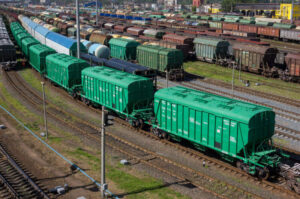
In 2023, Ukrzaliznytsia (UZ) transported 148.4 million tons of cargo by all types of traffic, down 1.5% from 2022 and due to the availability of pre-war January-February 2022 in the comparison database, the company’s website reports.
According to it, from March to December 2023, UZ transported an average of 23% more cargo per month than in the same period in 2022.
It is specified that November was a record month last year, when the company transported 14.1 million tons of cargo.
According to the release, 22.3 million tons of cargo were transported to seaports for further export last year, while 34.4 million tons were exported via land crossings.
Domestic transportation in 2023 increased by 11.4% to 84.8 million tons compared to 2022.
According to UZ, the leaders in terms of cargo volumes in 2023 were grains – 30.6 million tons (+5.9%), construction materials – 29.6 million tons (+29.6%), iron and manganese ore – 27.5 million tons (-13.2%), coal – 26.2 million tons (-11.2%) and ferrous metals – 8.2 million tons (-10.6%).
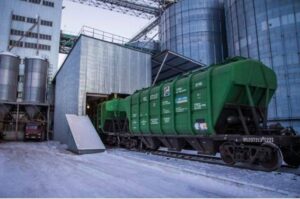
In 2023, Ukrzaliznytsia JSC transported 30.58 million tons of grain cargo, up 5.9%, or 1.708 million tons, from a year earlier, said Valery Tkachev, deputy director of the commercial work department of UZ, at a meeting with agricultural market participants on Thursday.
According to him, 22.729 mln tons of grain crops were transported for export by rail, which is 178 thsd tonnes more than in 2022. Of these, 14.324 mln tonnes (-4.9%) were shipped to the ports, and 8 mln 405 thsd tonnes (+12.2%) – to the western border crossings.
“Before the embargo on imports of Ukrainian grain by neighboring countries was imposed in April, 900 thsd tonnes to 1 mln tonnes of grain were transported by rail per month. After the ban was imposed, the volume was almost halved. The work of ports in 2023 was significantly affected by the uncertainty of the “grain corridor”, Tkachev stated.
As reported, Ukrzaliznytsia transported 63 million tons of cargo for export in 2023.
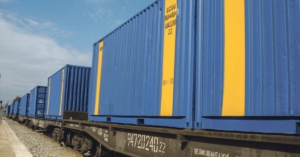
In 2023, Ukrzaliznytsia (UZ) transported 201.26 thousand twenty-foot equivalent containers (TEUs), up 34% from 2022 and in line with the figures for 2019 before the war, Valery Tkachev, deputy director of the company’s commercial department, said on Wednesday at a meeting on the development of intermodal transportation.
According to him, before Russia’s full-scale invasion, UZ’s container transportation had been growing by 11-22% for four years, including 14% in 2021, but after Russia’s full-scale invasion in 2022, it fell by 46% to 150 thousand TEUs.
“If in 2021 we already reached 279,792 thousand TEU, in 2022 we fell to 150 thousand TEU, that is, 46%,” Tkachev emphasized.
He noted that the rapid recovery of container transportation in 2023 was due to the blocking of Ukrainian seaports.
“If you look at the traffic, 62% of all container transportation is export, 19% is domestic transportation, and 19% is import,” he described the market.
The UZ representative added that grain is the most popular containerized cargo, accounting for 49%. Ferrous metals are in second place (17%), followed by oil cake (14%) and oil (10%).
Tkachev emphasized that the 2023 figures, although positive, are significantly lower than those set out in the development strategy of Ukrzaliznytsia, which provided for the transportation of more than 1 million TEUs per year.
He reminded that in March 2023, UZ launched the intermodal train service, and almost 200 trains were sent.
At the same time, the deputy director of the commercial work department noted that after testing the counter-rail transportation to Poland in December 2023, problems with tariffication arose.
“We are still receiving invoices from the Polish side. There was an agreement on a comprehensive rate, but for some reason the Polish colleagues continue to adjust it, so we are now working with the Polish side to get a single comprehensive rate for this service, and then we will be able to work more rhythmically and transport container trains,” added Tkachev.